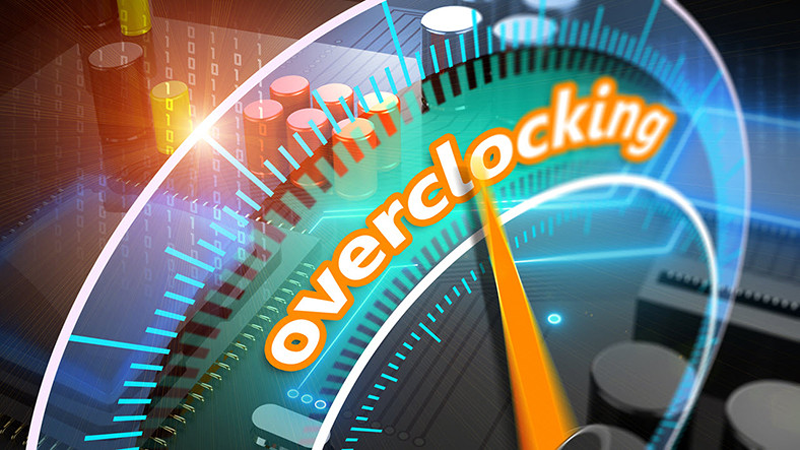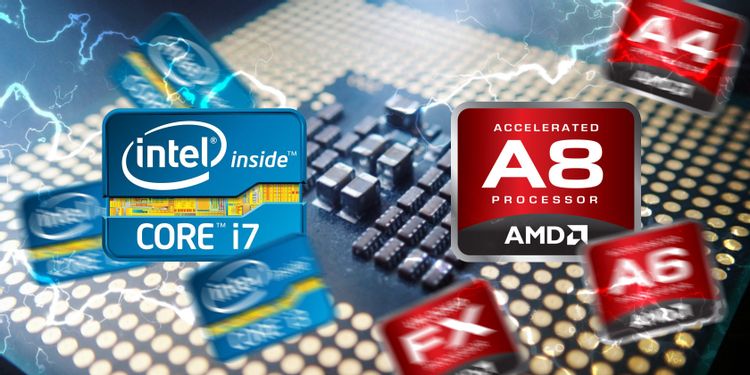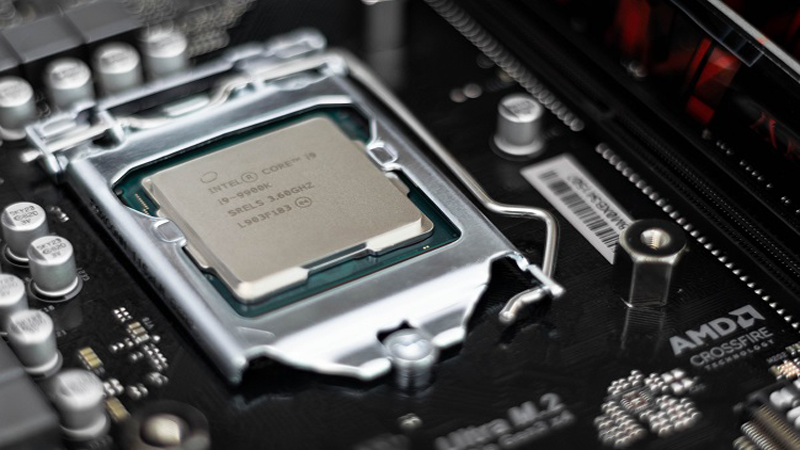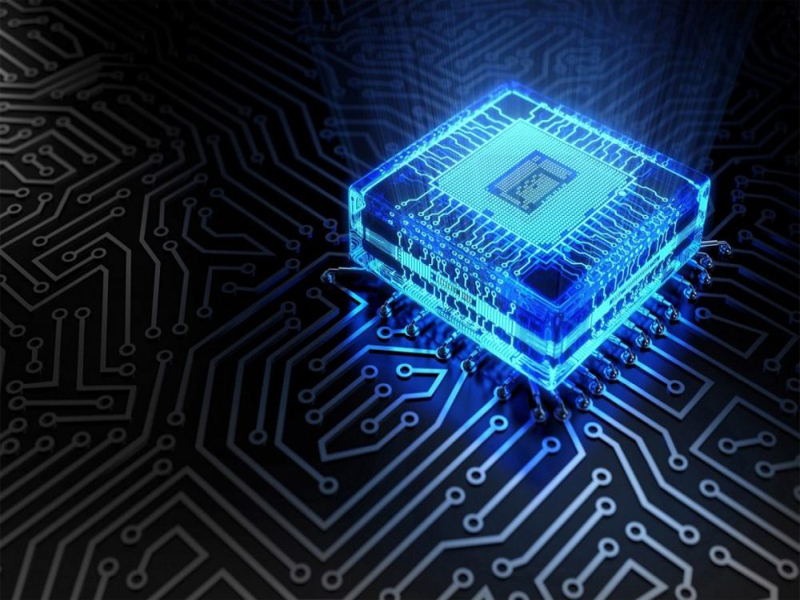Learn about overclocking: Should or shouldn't overclock?
So what does overclocking do and how risky is it? Let's learn about overclocking in today's article!
1. What is overclocking?
Overclocking is a method of pushing the CPU clock speed beyond the rated limit. Clock speed is the number of cycles your CPU can complete in one second, measured in units of Hertz (Hz). You can overclock to achieve higher clock speeds, allowing your processor to complete more instructions, more math per second.

The components that can be overclocked are usually the motherboard chip, CPU, video card, or RAM. However, there is no exact number on how fast we can increase the processing speed. The reason is that each overclock will give different results.
Overclocking also results in changes to power settings, voltages, kernels, memory or other critical system values so that the part can run at the desired high spec, thereby increasing computer performance.
2. Pros and cons of overclocking
Overclocking can improve information processing speed but also brings risks, harming other components - especially when not successfully overclocked. Therefore, I will clearly analyze the advantages and disadvantages of overclocking so that you can get the most objective view.
Advantages
Improve performance: The main goal of overclocking is to increase the performance of your computer. Some graphics intensive programs and games require the computer's performance to be powerful enough to handle and this condition can be met when we overclock. Overclocking the CPU/GPU will increase the clock speed, thereby boosting the overall performance of the computer.
Cost savings: Basically, overclocking can save us a lot of money. For example, you might be able to buy a cheaper graphics card and overclock it to get the same performance as a more expensive graphics card.
Maximize speed: Through overclocking, users can unleash the full potential of the components inside the computer. Adjust the performance speed to your liking.
Upgrade equipment: Overclocking can also make old devices and components work better, especially non-removable hardware and components.
Defect
Damage to other components and components: Always overclocking to a higher level will lead to damage to the computer's hardware. Overclocked hardware tends to overheat because the voltage is pushed too high or isn't designed for overclocking. Accordingly, the overall lifespan of hardware and components will also be significantly reduced.
Overheating: Hardware and components inevitably release excess heat caused during overclocking. If only the cooling fan alone cannot remove this excess heat, we need to install an additional liquid cooling system. Without a cooling system, the system can experience frequent problems in operation or even permanent hardware damage.
Power Consumption: Overclocking boosts performance but at the same time can double power consumption. An increased clock speed always draws more power from the computer source (PSU). Therefore, a system that has undergone overclocking will not be able to save power.
Warranty: Most hardware warranties are void after you overclock, unless you're using overclocked hardware from the manufacturer. These manufacturers will likely replace or repair components damaged by overclocking.
I have one more note for you, that overclocking on a laptop is much more dangerous than on a desktop computer because the cooling system on a laptop is still limited. Even the laptop's CPU can be burned if the device is too hot and this is very dangerous.
3. Basic Overclocking Steps
Check the hardware and components to see if they support overclocking
If you want to overclock your computer, first consider whether your processor supports overclocking because not all devices support overclocking and there are 2 ways to overclock: manual overclocking and overclocking. automatic overclocking.
While automatic overclocking is simpler, it doesn't offer the same level of nuance and control as the manual route. Manual overclocking allows you to precisely adjust CPU settings step by step to your liking, so you can reduce the risk of overheating.

Some CPU models on the market today that allow users to overclock such as Intel CPUs with the letter 'K' (Intel Core i7 9700K) or processors from the Intel X series can be overclocked. In July 2019, Intel released an automatic overclocking tool for a range of its powerful gaming processors.
In addition, new AMD Ryzen CPUs are unlocked and overclockable. However, if you use older devices, do a Google search to see if the component can be overclocked to be safe!
Check CPU core temperature
Overclocking will increase the core temperature of your CPU, so it's a good idea to measure your CPU temperature first so you can establish a baseline for your next steps and so you can compare any changes you experience when overclocking. pulse.

There are 2 ways to check CPU core temperature:
- Check CPU temperature with monitoring software: Intel and AMD both provide CPU temperature monitoring software for their products. You can also use Core Temp software to check your CPU's core temperature.
- Check CPU core temperature in UEFI/BIOS: Functionally, UEFI and BIOS are the same. In newer computers running Windows 10, the BIOS has been replaced with an update called UEFI (unified extensible firmware interface).
Monitor CPU stability under high pressure
This step is done to ensure that your CPU is stable enough to overclock. Otherwise, the CPU runs the risk of burning out if it overheats and causes irreparable damage to your computer.
For safety, please do by checking the CPU's ability to operate under high pressure. You can use Prime95 or IBT software to test and push the CPU to full capacity, then see how the CPU handles the workload
Evaluate the current performance of the CPU

Set up benchmarks for your CPU so you can evaluate overclocking results, you can use Cinebench software to evaluate CPU performance or 3DMark , CPU scoring software for gaming devices.
Access your computer's UEFI or BIOS
You'll need to go into your computer's UEFI (or BIOS on older devices) and find the overclocking tab. If you are using Windows 10, you can access this through the Settings menu.
- Access the settings menu (or you can use the keyboard shortcut Windown + I ), then select Update & Security .
- Next select Recovery .
- Select Restart in the Advanced startup heading .
- Your computer will reboot, then it will display a menu with different boot options. You click Troubleshoot .
- In the next menu, select Advanced options > UEFI Firmware Settings , then click Restart . After the computer restarts it will show UEFI, from here you can adjust the clock factor.
Choose overclocking factor
At this step, you should only do it for manual overclocking, and for automatic overclocking, the system will choose the multiplier by itself. So that you won't need to do it yourself, you can skip this step and move on to the final stage. When increasing the CPU factor, you have to be very careful because if you adjust it improperly, you can damage the hardware more seriously than damage the computer.
To test your CPU's endurance and monitor the temperature, you can increase the multiplier for one core, then go back and increase the other cores. The more cores you overclock, the hotter the system runs. You can only increase the multiplier high before the CPU goes over the limit.
Check
This is the critical stage of the whole process, each time you increase the multiplier or voltage, save the setting, reboot and test. Run the CPU endurance test tool then the benchmark tool and monitor the CPU's temperature during operation. After your benchmarking tool has completed its assessment, compare the new score (after overclock) with the original score (before overclock) of the computer for comparison.
4. Should I overclock my computer?
In general, overclocking will depend on the needs of each person. Overclocking is very popular among computer enthusiasts, gamers or those who often use graphics-heavy tasks.
However, in recent years, there is some evidence that overclocking is not as useful as it once was. Modern computer CPUs have much more powerful performance, so overclocking doesn't make much sense.
What's more, improving processor performance can be useless if the rest of your computer isn't fast enough to keep up (also known as a 'bottleneck'). As I mentioned above, overclocking no matter how beneficial it is, there are still many risks and dangers to the computer, so overclocking is only suitable for those who have experience and knowledge of the software. computer hardware.
Conclude
Although overclocking improves computer performance in many ways, it is not the best method. If handled carelessly, overclocking can cause some serious damage to the components inside the computer. Therefore, you need to be aware of both the benefits and the risks before undertaking this process.
You should read it
- Instructions for overclocking the CPU
- Everything you need to know about overclocking your Raspberry Pi 5
- Should overclock to increase performance for gaming PC?
- Things to know about overclocking computers
- 6 best overclocking software to boost PC performance
- Intel launches automatic CPU overclocking tool with one click
- Instructions for overclocking graphics cards for better gaming performance
- Overclock CPU, GPU and RAM easily and safely
May be interested
- How to overclock GPU to optimize computer performance
 overclocking your gpu is a popular way to increase the performance of your graphics card, increasing the speed of image and video processing. this article will guide you in detail on how to do it.
overclocking your gpu is a popular way to increase the performance of your graphics card, increasing the speed of image and video processing. this article will guide you in detail on how to do it. - 6 best overclocking software to boost PC performance
 this is a list of the best overclocking apps to help you overclock your processor (cpu) and graphics card (gpu).
this is a list of the best overclocking apps to help you overclock your processor (cpu) and graphics card (gpu). - How to overclock Raspberry Pi 3
 although the old raspberry pi 3b and 3b+ models are not as powerful as the new pi 4 or pi 5, you can improve their performance by overclocking the cpu.
although the old raspberry pi 3b and 3b+ models are not as powerful as the new pi 4 or pi 5, you can improve their performance by overclocking the cpu. - What are the harmful effects of overclocking a graphics card?
 you should consider carefully before deciding to overclock your graphics card.
you should consider carefully before deciding to overclock your graphics card. - List of 6 overclocking software to effectively increase CPU processing speed
 overclocking software to increase cpu processing speed will help you optimize pc performance. join tipsmake to learn specifically about the 6 best quality overclocking software.
overclocking software to increase cpu processing speed will help you optimize pc performance. join tipsmake to learn specifically about the 6 best quality overclocking software. - How to overclock RAM easily with AMD Ryzen Master
 fortunately, users of windows computers running amd ryzen processors can use ryzen master to easily overclock ram without touching the bios.
fortunately, users of windows computers running amd ryzen processors can use ryzen master to easily overclock ram without touching the bios. - 5 tips to help make optimal use of Tomato on the Router
 in the following article, we will show you the 5 most useful tips for tomato, which help speed up your router and your work is done faster.
in the following article, we will show you the 5 most useful tips for tomato, which help speed up your router and your work is done faster. - Things to know about overclocking computers
 many people may not know what overclocking is but at least have heard this term before. simply put, overclocking is the process of making a computer part like a microprocessor run with specifications higher than the manufacturer's specs.
many people may not know what overclocking is but at least have heard this term before. simply put, overclocking is the process of making a computer part like a microprocessor run with specifications higher than the manufacturer's specs. - Instructions for overclocking graphics cards for better gaming performance
 if you want your computer's graphics card to have a little extra power without spending a lot of money on a new model, overclocking the gpu is a simple way to do this. and it is really simple especially on windows computers. although this process takes a long time, it does not require any specific knowledge or advanced skills.
if you want your computer's graphics card to have a little extra power without spending a lot of money on a new model, overclocking the gpu is a simple way to do this. and it is really simple especially on windows computers. although this process takes a long time, it does not require any specific knowledge or advanced skills. - Redmi K30 Pro can overclock the screen from 60Hz to 80Hz
 overclocking the screen to 80hz will help the redmi k30 pro play games smoother, but this also carries many risks and can permanently void the warranty.
overclocking the screen to 80hz will help the redmi k30 pro play games smoother, but this also carries many risks and can permanently void the warranty.










 Compare Apple AirTag and Samsung Galaxy SmartTag
Compare Apple AirTag and Samsung Galaxy SmartTag How to update the software for the Amazon Kindle e-reader
How to update the software for the Amazon Kindle e-reader Detailed review of OPPO Find X3 Pro 5G: A big step forward!
Detailed review of OPPO Find X3 Pro 5G: A big step forward! Check the hard drive for Bad Sector and Bad Sector recognition signs
Check the hard drive for Bad Sector and Bad Sector recognition signs Review Razer Huntsman V2 Analog mechanical keyboard phím
Review Razer Huntsman V2 Analog mechanical keyboard phím What connection ports do projectors usually have?
What connection ports do projectors usually have?